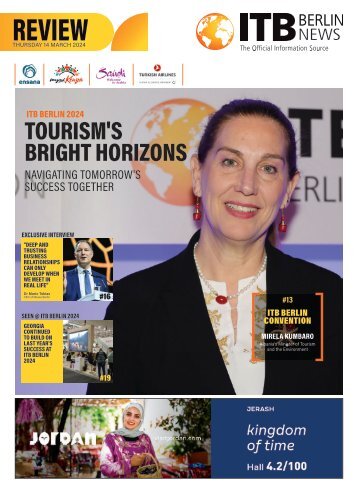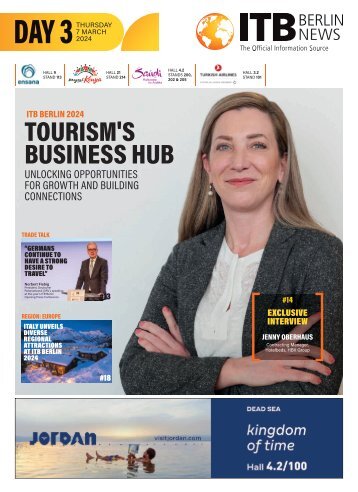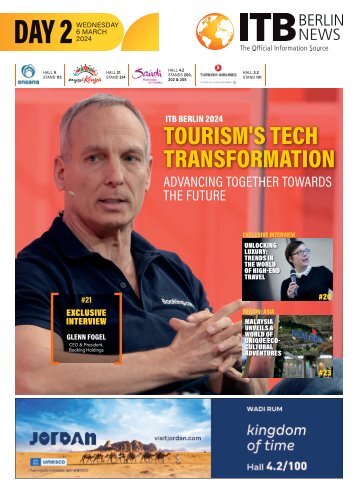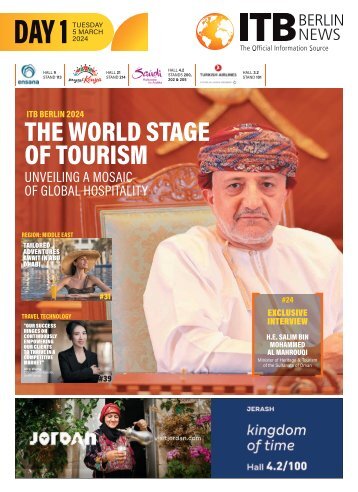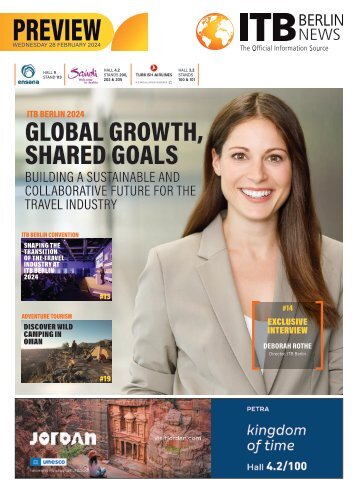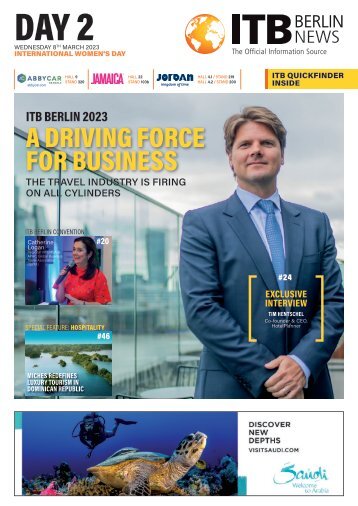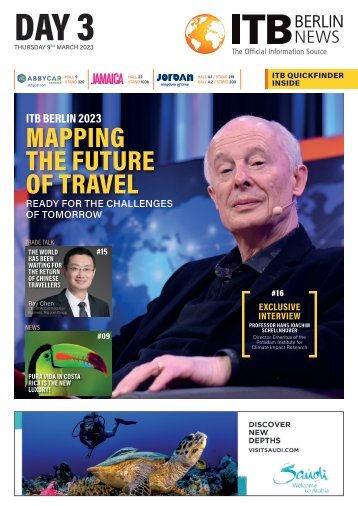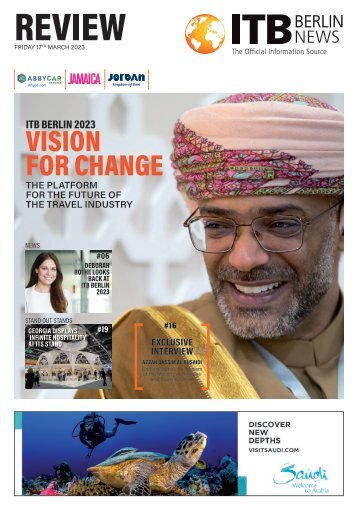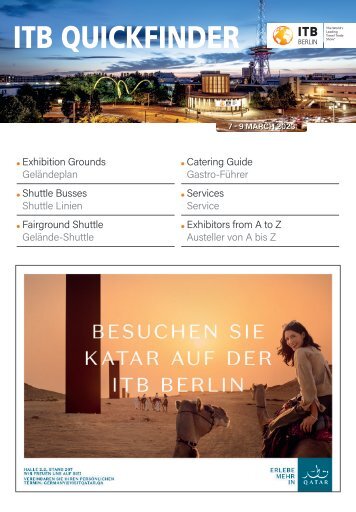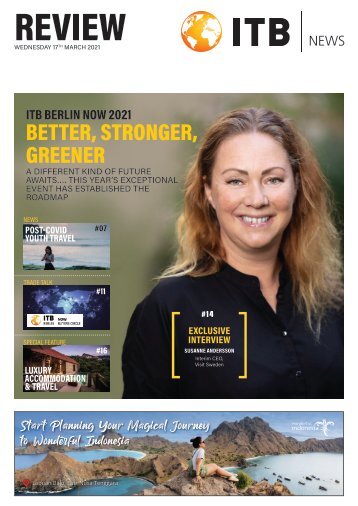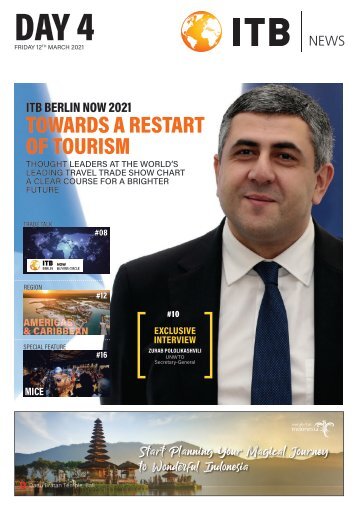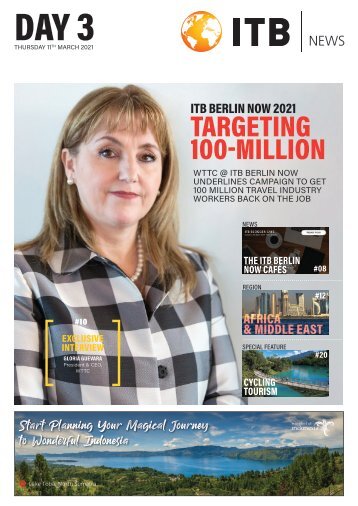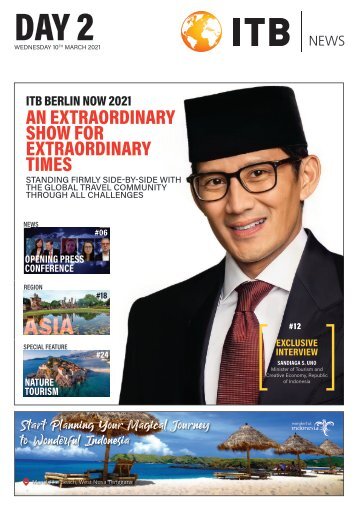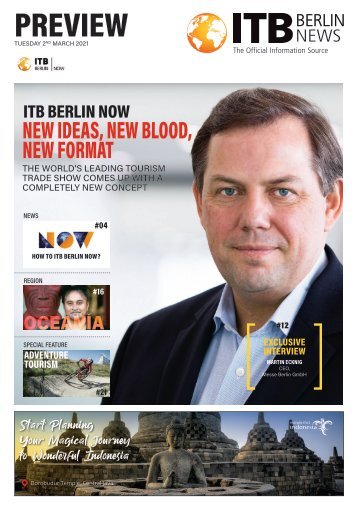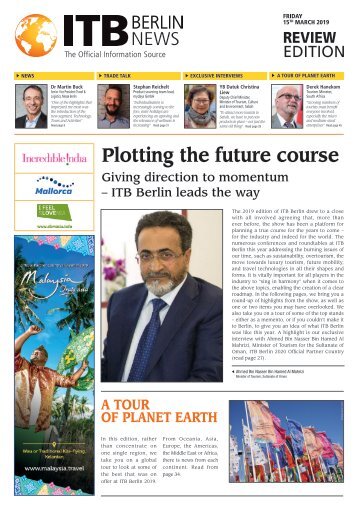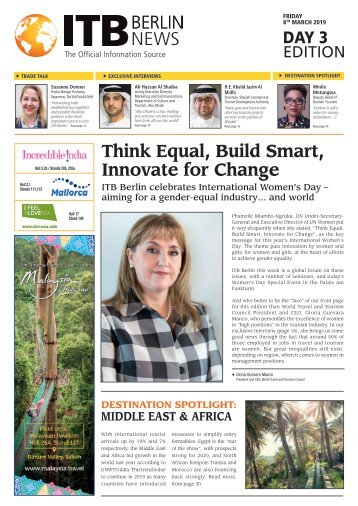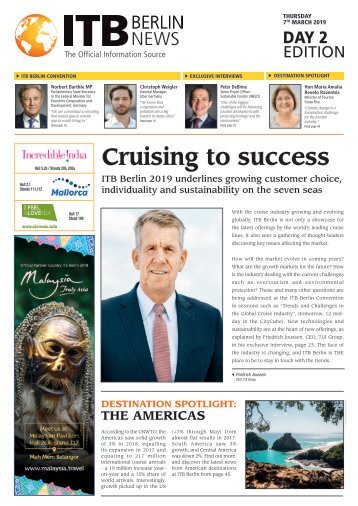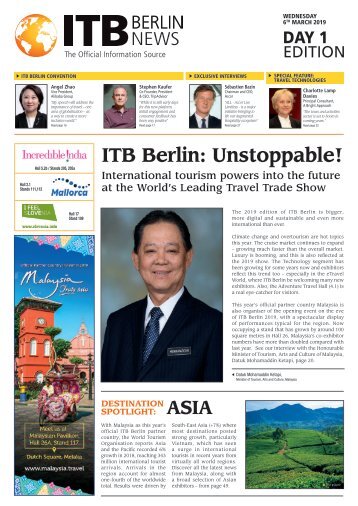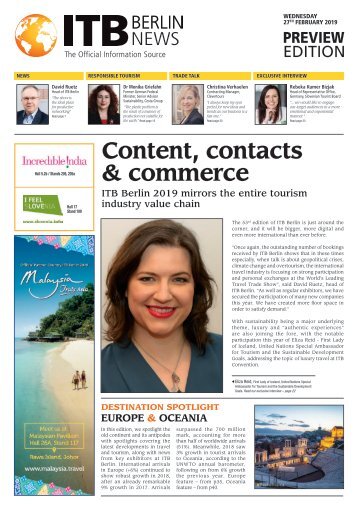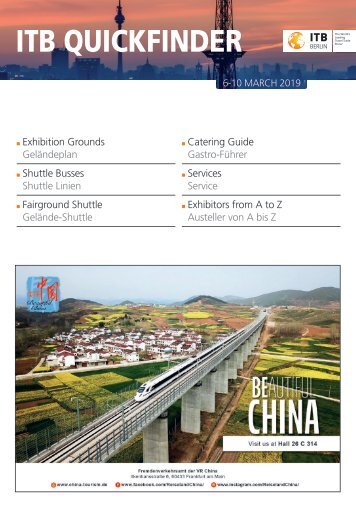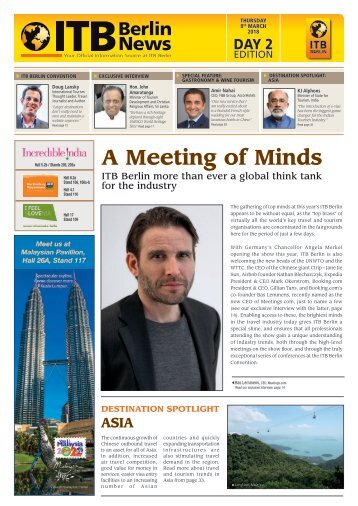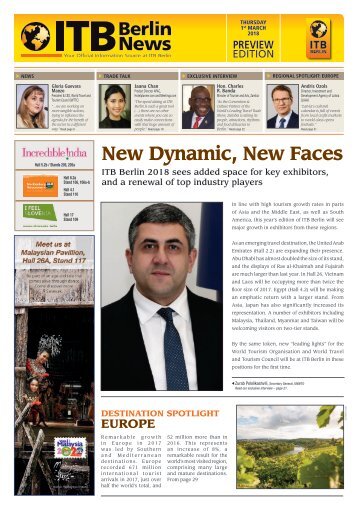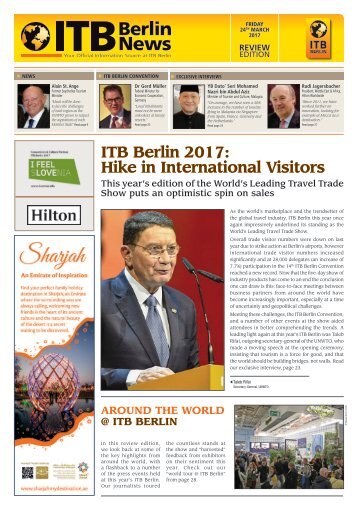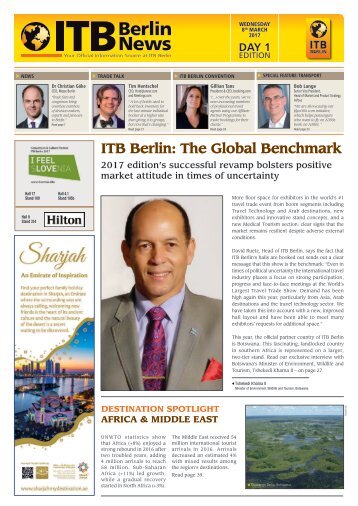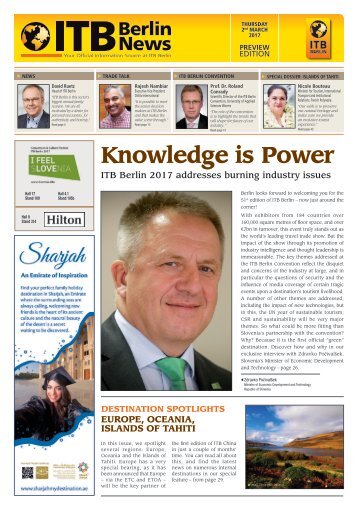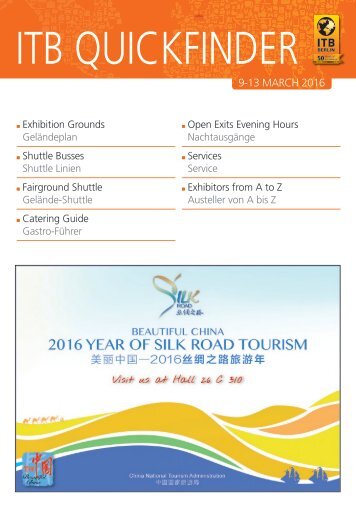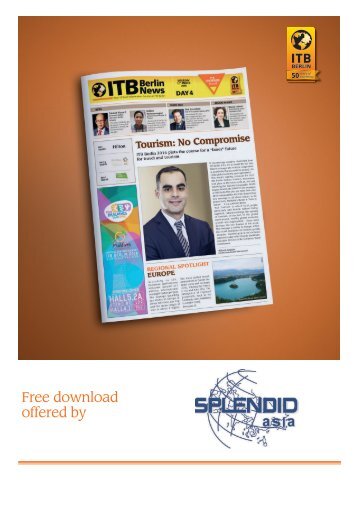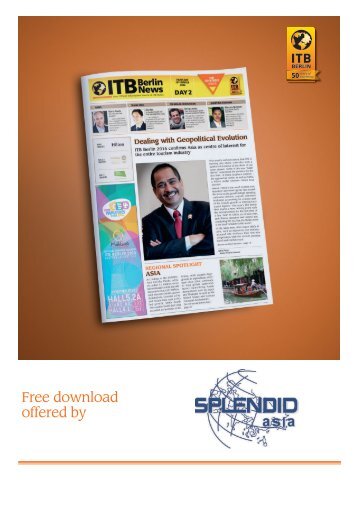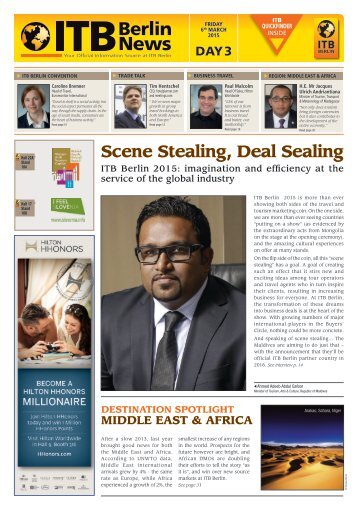
ITB Berlin News - Day 1
- Text
- Hotels
- Tourism
- Resort
- Tours
- Resorts
- Maldives
- Berlin
- Exhibitors
- Halle
- Tourismus
68 REGION AFRICA &
68 REGION AFRICA & MIDDLE EAST Bringing Down the Borders Southern Africa’s KAZA TFCA project under the spotlight at ITB Berlin With the aim of establishing a world-class Transfrontier Conservation & Tourism Destination in the Okavango and Zambezi River Basin in the context of sustainable development, organisers of the KAZA TFCA project are counting on ITB Berlin to spread awareness on a global scale. We asked Dr. Morris Mtsambiwa, the Executive Director of the KAZA Secretariat to tell us a little more about KAZA TFCA as it stands, and what his key aims are with the project. KAZA is one of the world’s largest conservation areas, spanning 520,000 km2 over five Southern African countries i.e. Angola, Botswana, Namibia, Zambia and Zimbabwe. It includes 36 national parks; three World Heritage Sites (Victoria Falls, the Okavango Delta and Tsolido Hills); and is the habitat of the world’s largest elephant and wild dog populations at about 250,000 and 2,500 animals respectively. The KAZA landscape is also home to two million people representing a rich cultural diversity. The key aim of this project is to ensure that these resources are conserved to balance the needs of nature conservation and wildlife protection with the demands of providing sustainable livelihoods for its resident human communities. These resources are under threat and we aim to mitigate it by: • Facilitating free movement of wildlife across their traditional routes, and from areas of higher concentration to sparsely populated areas along cross border wildlife dispersal areas or corridors. Six such Wildlife Dispersal Areas (WDAs) have been identified, and transboundary nature activities promoting these WDAs and mitigating human wildlife conflict will be undertaken; • Increasing conservation benefits to communities by supporting livelihoods in terms of fishing, agriculture and tourism; and again mitigate human-wildlife conflict; • Tourism development to make KAZA TFCA a premier tourist destination by facilitating easy movement of tourists across international/ regional borders through the univisa; and development and promotion of crossborder tourism products and greater cooperation amongst key players; • Economic and Environmental development within the region to coordinate policy harmonisation; • anti-poaching efforts and land-use measures. What are your biggest challenges to this? Fostering a greater understanding of the importance of the KAZA TFCA, where we have to contend with a skewed benefit sharing system. While the landscape is endowed with rich resources that promote tourism, local communities are not benefitting therefrom. Poverty remains high among these communities who also suffer the most from human wildlife conflict without compensation. We are working on promoting local participation in the tourism supply chain to make them realise the benefits from tourism development. What are some of the more interesting projects that are part of this that you can tell us about? KAZA TFCA has been promoting free movement of tourists across its borders through the development of the KAZA UNIVISA. The pilot phase was launched in November 2014 between Zambia and Zimbabwe, and again at ITB 2015 on the Zambian stand. The pilot phase was successfully completed in December 2015 and the two countries Dr. Morris Mtsambiwa Executive Director, KAZA Secretariat have now requested the other Partner Countries i.e. Angola, Botswana and Namibia to expand the next phase of the univisa. Zambia and Zimbabwe will continue issuing the visa, while streamlining modalities to integrate it into their immigration management system to reduce the time it takes to issue the visa. KAZA TFCA has also joined hands with Futouris under their flagship project, Sustainable Lodges, to develop standards (both environmental and socioeconomic) for tourist facilities in the KAZA area to be certified and to promote the KAZA brand. As the number of sustainably Hwange National Park, Zimbabwe operating lodges increase, they will be incorporated into the Futouris operators’ product portfolios allowing them to “green” their own supply chains. More than fifty lodges in the KAZA area have been certified in accordance with internationally accepted sustainability standards. What are you hoping to achieve at ITB? We hope to increase awareness of the extraordinary KAZA conservation and environmental story in the hope to attract more international tour operators to include it as a new route or destination. Hall 20 / Stand 106 ©JackyR ITB BERLIN NEWS • Wednesday 9 th March 2016 www.itb-berlin-news.com
© Thomas Keller HOSPITALITY / RESTAURANTS / BARS WHERE TO GO IN Berlin CLUBS / EVENTS / SHOPPING / CULTURE A Magical Metropolis On the 50 th anniversary of the world’s largest travel show, the Mayor of Berlin, Michael Müller, tells ITB Berlin News why Berlin itself should be celebrated, and enjoyed. He begins by explaining how far the city has travelled in the half century since ITB Berlin began. Michael Müller Mayor of Berlin From a divided city, Berlin has become a thriving metropolis, and has in the last quarter of a century, magically attracted people from all over the world. Therefore, we have recorded more than thirty million overnight stays in the past year. More and more visitors come to Berlin and are fascinated by the city: whether it is the cultural landscape, the historical locations, the parks and waterways, or the club scene, Berlin has something for everyone. It is not only cosmopolitan, tolerant and lovable, but also a very livable metropolis. What is your key message for visitors attending ITB? Enjoy the city, do great business, stay a little longer and please come back again. In addition, I would like to express the wish that you recommend Berlin when you get home! What is special about Berlin? I think the mixture in Berlin is unique. A mixture of old and new, of people from all over the world, of city and nature. Especially in the last 25 years, the city has blossomed and changed its face, becoming more cosmopolitan, diverse and colourful. Berlin is a centre of innovation with a diverse startup scene ENJOY THE CITY, DO GREAT BUSINESS, STAY A LITTLE LONGER AND PLEASE COME BACK AGAIN. and is increasingly becoming a hub for high-tech industries. Finally, Berlin is one of the most culturally attractive cities in the world. Famous museums, theatres and three opera houses are among the most famous attractions. Which city destinations would you recommend for new visitors to the city? That is always difficult for the mayor of the city to say, because they are all exciting in their way. Berlin is so diverse and has so many faces. I recommend that visitors try to understand this diversity by exploring the entre city. Perhaps the city centre around Mitte best embodies the proverbial «Berlin mix» of East and West, nature and culture, old and new. ITB BERLIN NEWS • Wednesday 9 th March 2016
- Page 1 and 2:
Free download offered by
- Page 3:
WEDNESDAY 9 th MARCH 2016 DAY 1 ITB
- Page 7 and 8:
NEWS 5 FROM ‘66TO‘16 50 gloriou
- Page 9:
NEWS 7 NOT TO BE MISSED! Today, Wed
- Page 14:
12 NEWS The Evolution of the Travel
- Page 21 and 22: ITB BERLIN CONVENTION 19 ITB Berlin
- Page 23: EXCLUSIVE INTERVIEW 21 National Eco
- Page 27 and 28: CITY BREAKS SPECIAL FEATURE 25 Djem
- Page 29 and 30: CITY BREAKS SPECIAL FEATURE 27 ADVE
- Page 31 and 32: CITY BREAKS SPECIAL FEATURE 29 ADVE
- Page 33 and 34: TRAVEL TECHNOLOGIES SPECIAL FEATURE
- Page 35 and 36: TRANSPORT SPECIAL FEATURE 33 Transp
- Page 37 and 38: TRANSPORT SPECIAL FEATURE 35 Singap
- Page 39: TRANSPORT SPECIAL FEATURE 37 EMPOWE
- Page 45: SPECIAL DOSSIER: MALDIVES 43 2016:
- Page 48 and 49: ITB BERLIN NEWS • Wednesday 9 th
- Page 51: SPECIAL DOSSIER: MALDIVES 49 : A
- Page 55 and 56: SPECIAL DOSSIER: MALDIVES 53 Smart,
- Page 57: SPECIAL DOSSIER: MALDIVES 55 ADVERT
- Page 61: SPECIAL DOSSIER: MALDIVES 59 When S
- Page 64 and 65: 62 SPECIAL DOSSIER: MALDIVES MORE G
- Page 67 and 68: AFRICA & MIDDLE EAST REGION 65 Fami
- Page 69: AFRICA & MIDDLE EAST REGION 67 Keny
- Page 75 and 76: ITB QUICKFINDER 9-13 MARCH 2016 Exh
- Page 77 and 78: Hall 26 A / Stand 106b Hall 26 A /
- Page 79 and 80: CATERING GUIDE & OPEN EXITS EVENING
- Page 81 and 82: EXHIBITORS FROM A TO Z / AUSTELLER
- Page 83 and 84: A / B EXHIBITORS / AUSSTELLER HALL
- Page 85 and 86: B / C EXHIBITORS / AUSSTELLER HALL
- Page 87 and 88: C / D / E EXHIBITORS / AUSSTELLER H
- Page 89 and 90: E / F / G EXHIBITORS / AUSSTELLER H
- Page 91 and 92: G / H / I EXHIBITORS / AUSSTELLER H
- Page 93 and 94: I / J / K / L EXHIBITORS / AUSSTELL
- Page 95 and 96: L / M / N EXHIBITORS / AUSSTELLER H
- Page 97 and 98: N / O / P / Q EXHIBITORS / AUSSTELL
- Page 99 and 100: Q / R / S EXHIBITORS / AUSSTELLER H
- Page 101 and 102: S / T EXHIBITORS / AUSSTELLER HALL
- Page 103 and 104: T / U / V EXHIBITORS / AUSSTELLER H
- Page 105: V / W / X / Y / Z EXHIBITORS / AUSS
Inappropriate
Loading...
Mail this publication
Loading...
Embed
Loading...
